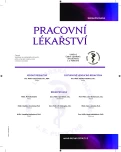Low back pain as an occupational disease
Authors:
Nakládalová Marie 1; Urban Pavel 2; Hlávková Jana 2; Ehler Edvard 3; Ridzoň Petr 4,5; Boriková Alena 1; Laštovková Andrea 4; Pelclová Daniela 4
Authors‘ workplace:
Klinika pracovního lékařství, LF UP a FN Olomouc, přednostka doc. MUDr. Marie Nakládalová, Ph. D.
1; Státní zdravotní ústav Praha, ředitelka Ing. Jitka Sosnovcová
2; Neurologická klinika PKN, a. s. a FZS Univerzity Pardubice, přednosta doc. MUDr. Edvard Ehler, CSc.
3; Klinika pracovního lékařství, 1. LF UK a VFN Praha, přednostka prof. MUDr. Daniela Pelclová, CSc.
4; Neurologické oddělení Thomayerovy nemocnice, Praha, prim. MUDr. Jolana Marková
5
Published in:
Pracov. Lék., 66, 2014, No. 2-3, s. 94-97.
Category:
Review article
Overview
Although vertebrogenic algic syndrome or back pain is a very common disease of multifactorial etiology, epidemiological studies have shown a statistically significant association with certain types of occupational burden. In practice, the contribution of occupational exposure to the development of these conditions is important for two reasons. First, it may be considered essentially preventable. Second, cases with a significant contribution of occupational etiology may be viewed as occupational diseases for which compensation may be claimed, as is the case in many European Union countries. In the Czech Republic, however, there is no such possibility. A prerequisite for including these conditions in the list of occupational diseases is development of an objective method for evaluating the contribution of occupational factors to their etiology and determination of clinical criteria for their classification as occupational diseases.
Klíčová slova:
back pain – occupational diseases – risk factors
Sources
1. Deyo, R. A., Einstein, J. N. Low Back Pain. N. Engl. J. Med., 2001, 344, 5, s. 363–370.
2. Gourmelen, J., Chastang, J. F,, Ozguler, A. et al. Frequency of low back pain among men and women aged 30 to 64 years in France. Results of two national surveys. Ann. Readapt. Med. Phys., 2007, 50, s. 640–644.
2. Hoy, D., Brooks, P., Blyth, F. et al. The Epidemiology of low back pain. Best Practice and Research Clinical Rheumatology, 2010, 24, s. 769–781.
3. Kuiper, J. I., Burdorf, A., Frings-Dresen, M. H. W. et al. Assessing the work-relatedness of nonspecific low-back pain. Scand. J. Work Environ. Health, 2005, 31, 3, s. 237–243.
4. Lötters, F., Burdorf, A., Kuiper, J. et al. Model for work-relatedness of low-backpain. , 2003, 29, 6, s. 431–440.
5. Plouvier, S., Gourmelen, J., Chastang, J. F. et al. Low back pain around retirement age and physical occupational exposure during working life. Publ. Health, 2011, 11, s. 268–274.
6. Raschke, U., Martin, B. J., Chaffin, D. B. Distributed Moment Histogram: A Neurophysiology Based Method of Agonist and Antagonist Trunk Muscle Activity Prediction. J. Biomechanics, 1996, 29, 12, s. 1587–1596.
7. Van der Beek, A. J., Frings-Dresen, M. H. W. Assessment of mechanical exposure in ergonomic epidemiology. Occup. Environ. Med., 1998, 55, s. 291–299.
8. Ústav zdravotnických informací a statistiky České republiky, aktuální informace č. 2, 2013. s. 2.
Labels
Hygiene and epidemiology Hyperbaric medicine Occupational medicineArticle was published in
Occupational Medicine

2014 Issue 2-3
Most read in this issue
- Lateral epicondylitis of humerus in clinical practice of the occupational diseases ward
- Saturation diving – the Hydronaut Project
- Kinesiotherapy in the carpal tunnel syndrome
- Low back pain as an occupational disease
